|
Meinem Lehrer und Freund Prof. Dr. Heinrich von Stietencron in Dankbarkeit gewidmet. |
Zitierweise | cite as: Amarasiṃha <6./8. Jhdt. n. Chr.>: Nāmaliṅgānuśāsana (Amarakośa) / übersetzt von Alois Payer <1944 - >. -- 1. Prathamam kāṇḍam. -- 4. kālavargaḥ. -- Fassung vom 2010-08-22. -- URL: http://www.payer.de/amarakosa/amara104.htm
Erstmals hier publiziert: 2010-08-21
Überarbeitungen: 2010-08-22 [Verbesserungen]
©opyright: Creative Commons Lizenz (Namensnennung, keine kommerzielle Nutzung, share alike)
Dieser Text ist Teil der Abteilung Sanskrit von Tüpfli's Global Village Library
|
Meinem Lehrer und Freund Prof. Dr. Heinrich von Stietencron in Dankbarkeit gewidmet. |
Falls Sie die diakritischen Zeichen nicht dargestellt bekommen, installieren Sie eine Schrift mit Diakritika wie z.B. Tahoma.
Die Devanāgarī-Zeichen sind in Unicode kodiert. Sie benötigen also eine Unicode-Devanāgarī-Schrift.
Jātarūpa
Jātarūpa <vor 1119 n. Chr.>: Jātarūpa's Commentary on the Amarakoṣa : for the first time critically edited together with an introduction, appendices and indices / Mahes Raj Pant. - 2 Bde. -- Delhi [u.a.] : Motilal Banarsidass, 2000. -- Teilw. zugl.: Hamburg, Univ., Diss. von Mahes Raj Pant. -- ISBN 81-208-1690-0
Siehe auch:
Fleet, J. F. (John Faithful) <1847-1917>: Hindu Chronology (1910). -- (Quellenkunde zur indischen Geschichte bis 1858 / Alois Payer ; 3. Inschriften, 5.). -- http://www.payer.de/quellenkunde/quellen035.htm
1.a./b. kālo diṣṭo 'py anehāpi samayo 'py atha pakṣatiḥ
कालो दिष्टो ऽप्य् अनेहापि समयो ऽप्य् अथ पक्षतिः ।१ ॥
[Bezeichnungen für Zeit sind:]
1. kālo diṣṭo 'py anehāpi samayo 'py atha pakṣatiḥ
pratipad dve ime strītve tadādyās tithayo dvayoḥ
कालो दिष्टो
ऽप्य्
अनेहापि समयो
ऽप्य्
अथ पक्षतिः ।
प्रतिपद् द्वे इमे स्त्रीत्वे तदाद्यास् तिथयो
द्वयोः ॥१॥
[Bezeichnungen für den ersten Tag des zunehmenden oder abnehmenden Mondes (des halben monatlichen Mondzyklus) sind:]
1. c./d. pratipad dve ime strītve tadādyās tithayo dvayoḥ
2. a./b. ghasro dināhanī vā tu klībe divasa-vāsarau
प्रतिपद् द्वे इमे स्त्रीत्वे
तदाद्यास् तिथयो द्वयोः ॥१ ख्॥
घस्रो दिनाहनी वा तु क्लीबे दिवस-वासरौ ।२ क।
pakṣati bzw. pratipat als Erstes haben die तिथि m. f.: Mondtag (genau: 1/15 eines halben Mondzyklus bzw. 1/30 eines vollen Mondzyklus).
[Bezeichnungen für Tag2 sind:]
Erläuterungen:
1 tithi f.
"The lunar day.
The lunar fortnights are divided each into fifteen tithis or lunar days.3 The tithi is the lime in which the moon increases her distance from the sun round the circle by twelve degrees; and the almanacs show each tithi by its ending-time; that is, by the moment, expressed in ghaṭikās and palas, after sunrise, at which the moon completes that distance. In accordance with that, the tithi is usually used and cited with the weekday on which it ends; but there are special rules regarding certain rites, festivals, &c., which sometimes require the tithi to be used and cited with the weekday on which it begins or is current at a particular time. The first tithi of each fortnight begins immediately after the moment of new-moon and full-moon respectively ; the last tithi ends at the moment of full-moon and new-moon. The tithis are primarily denoted by the numbers 1, 2, 3, &c., for each fortnight; but, while the full-moon tithi is always numbered 15, the new-moon tithi is generally numbered 30, even where the pūrṇimānta month is used. The tithis may be cited either by their figures or by the Sanskrit ordinal words prathama, "first," dvitīya, "second," &c., or corruptions of them. But usually the first tithi of either fortnight is cited by the term pratipad, pratipada, and the new-moon and full-moon tithis are cited by the terms amāvāsyā and pūrṇimā; or here, again, corruptions of the Sanskrit terms are used. And special names are sometimes prefixed to the numbers of the tithis, according to the rites, festivals, &c., prescribed for them, or events or merits assigned to them: for instance, Vaiśākha śukla 3 is Akshaya or Akshayya-tṛitīya, the third tithi which ensures permanence to acts performed on it; Bhādrapada śukla 4 is Gaṇeśa-chaturthī, the fourth tithi dedicated to the worship of the god Gaṇeśa, Gaṇapati, and the amānta Bhādrapada or pūrṇimānta Āśvina kṛishṇa 13 is Kaliyugādi-trayodaśī, as being regarded (for some reason which is not apparent) as the anniversary of the beginning of the Kaliyuga, the present Age. The first tithi of the year is styled Saṃvatsara-pratipadā, which term answers closely to our "New Year's Day."
3 It is customary to render the term tithi by "lunar day:" it is, in fact, explained as such in Sanskrit works; and, as the tithis do mark the age of the moon by periods approximating to 24 hours, they are, in a sense, lunar days. But the tithi must not be confused with the lunar day of western astronomy, which is the interval, with a mean duration of about 24 hrs. 54 min., between two successive meridian passages of the moon."
[Quelle: Fleet, J. F. (John Faithful) <1847-1917>: Hindu Chronology. -- In: Encyclopaedia Britannica. -- 11. ed. -- Vol 13. -- 1910. -- S. 491 - 501.]
"The civil day.
The civil days of the lunar month begin, like those of the solar month, at sunrise, and bear in the same way the names of the weekdays. But they are numbered in a different manner; fortnight by fortnight and according to the tithis. The general rule is that the civil day takes the number of the tithi which is current at its sunrise. And the results are as follows. As the motions of the sun and the moon vary periodically, a tithi is of variable length, ranging, according to the Hindu calculations, from 21 hrs. 34 min. 24 sec. to 26 hrs. 6 min. 24 sec.: it may. therefore, be either shorter or longer than a civil day, the duration of which is practically 24 hours (one minute, roughly, more or less, according to the lime of the year). A tithi may end at any moment during the civil day; and ordinarily it ends on the civil day after that on which it begins, and covers only one sunrise and gives its number to the day on which it ends. It may, however, begin on one civil day and end on the next but one, and so cover two sunrises; and it is then treated as a repeated tithi, in the sense that its number is repeated: for instance, if the seventh tithi so begins and ends, the civil day on which it begins is numbered 6, from the tithi which is current at the sunrise of that day and ends on it ; the day covered entirely by the seventh tithi is numbered 7, because that tithi is current at its sunrise; the next day, at the sunrise of which the seventh tithi is still current and during which it ends, is again numbered 7 ; and the number 8 falls to the next day after that, when the eighth tithi is current at sunrise.1 On the other hand, a tithi may begin and end during one and the same civil day, so as not to touch a sunrise at all: in this case, it exists for any practical purposes for which it may be wanted (it is, however, to be avoided if possible, as being an unlucky occasion), but it is suppressed or expunged for the numbering of the civil day, in the sense that its number is omitted; for instance, if the seventh tithi begins and ends during one civil day, that day is numbered 6 from, as before, the tithi which is current at its sunrise and ends when the seventh tithi begins; the next day is numbered 8, because the eighth tithi is current at its sunrise; and there is, in this case, no civil day bearing the number seven. In consequence of this method of numbering, it sometimes happens, as the result of the suppression of a tithi, that the day of a full-moon is numbered 14 instead of 15; that the day of a new-moon is numbered 14 instead of 30; and that the first day of a fortnight, and even the first day of a lunar year, is numbered 2 instead of 1.
1 We illustrate the ordinary occurrences. But there are others. Thus, a repeated tithi may occasionally be followed by a suppressed one: in this case the numbering of the civil days would be 6, 7, 7, 9, &c., instead of 6, 7, 7, 8, 9, &c. Or it may occasionally be preceded by a suppressed one: in this case the numbering would be 5, 7, 7, 8, &c., instead of 5, 6, 7, 7,8, &c.
There are, on an average, thirteen suppressed tithis and seven repeated tithis in twelve lunar months; and so the lunar year averages 354 days, rising to about 384 when a month is intercalated. It occasionally happens that there are two suppressions of tithis in one and the same fortnight; and the almanacs show such a case in the bright fortnight of Jyaishṭha, A.D. 1878: but this occurs only after very long intervals."
[Quelle: Fleet, J. F. (John Faithful) <1847-1917>: Hindu Chronology. -- In: Encyclopaedia Britannica. -- 11. ed. -- Vol 13. -- 1910. -- S. 491 - 501.]
2 Tag
"The civil day. The civil days of the solar month begin at sunrise. They are numbered I, 2, 3, &c., in unbroken succession to the end of the month. And, the length of the month being variable for the reasons stated above, the number of the civil days may range from twenty-nine to thirty-two."
[Quelle: Fleet, J. F. (John Faithful) <1847-1917>: Hindu Chronology. -- In: Encyclopaedia Britannica. -- 11. ed. -- Vol 13. -- 1910. -- S. 491 - 501.]
3 vāsara - वासर m. n.: Tag, Wochentag
Wochentag Sanskritbezeichnung Wandelstern Sonntag रविवासर m. - ravi-vāsara ravi = Sonne Montag सोमवासर m. - soma-vāsara soma = Mond Dienstag मंगलवासर m. - maṅgala-vāsara maṅgala = Mars Mittwoch बुधवासर m. - budha-vāsara budha = Merkur Donnerstag गुरुवासर m. - guru-vāsara /
बृहस्पतिवासर m - bṛhaspati-vāsaraguru / bṛhaspati = Jupiter Freitag शुक्रवासर m. - śukra-vāsara śukra = Venus Samstag शनिवासर m. - śani-vāsara śani = Saturn
2. c./d.
pratyūṣo 'harmukhaṃ kalyam uṣaḥ-pratyuṣasī api
3. a./b. prabhātaṃ ca dinānte tu sāyaṃ sandhyā pitṛprasūḥ
प्रत्यूषो
ऽह्र्मुखं कल्यम् उषः-प्रत्युषसी अपि ॥२ ख॥
प्रभातं च
दीनान्ते तु सायम् सन्ध्या
पितृप्रसूः ।३ क।
[Bezeichnungen für den Morgen / Tagesanbruch sind:]
Zum Tagesende sagt man साय n.: Abend
[Bezeichnungen für Dämmerung sind:]
3. c./d. prāhṇāparāhṇa-madhyāhnās trisandhyam atha śarvarī
प्राह्णापराह्ण-मध्याह्नास् त्रिसन्ध्यम् अथ शर्वरी ॥३ ख॥
Die drei Tageszeiten (त्रिसन्ध्य n.) heißen
3. c./d. prāhṇāparāhṇa-madhyāhnas-trisandhyam atha śarvarī
4. niśā niśīthinī rātris triyāmā kṣaṇadā kṣapā
vibhāvarī-tamasvinyau rajanī yāminī tamī
प्राह्णापराह्ण-मध्याह्नास् त्रिसन्ध्यम्
अथ शर्वरी ॥३ ख॥
निशा निशीथिनी रात्रिस् त्रियामा क्षणदा क्षपा ।
विभावरी-तमस्विन्यौ रजनी यामिनी तमी ॥४॥
Darauf folgt die Nacht. [Bezeichnungen für Nacht sind:]
5. a./b. tamisrā tāmasī rātrir jyautsnī candrikayānvitā
तमिस्रा तामसी रात्रिर् ज्यौत्स्नी चन्द्रिकयान्विता ।५ क।
Eine finstere Nacht nennt man
Eine von Mondschein (चन्द्रि्का) begleitete Nacht nennt man ज्यौत्स्नी f.: helle Nacht.
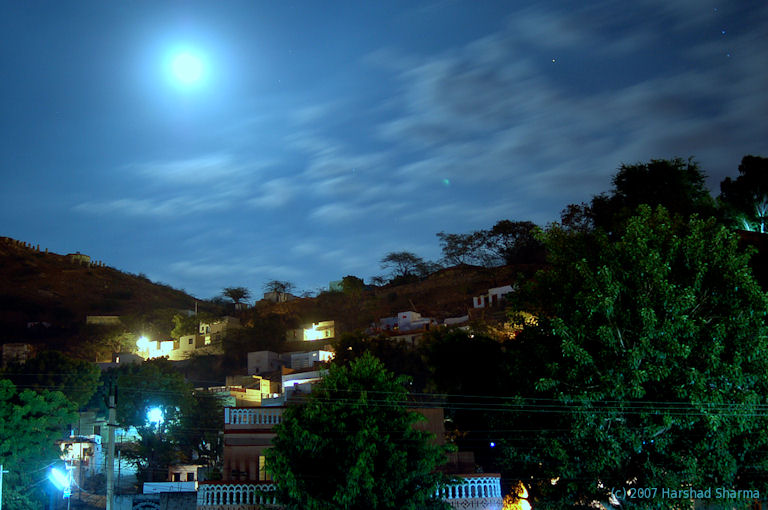
Abb.: ज्यौत्स्नी, Ajmer -
अजमेर, Rajasthan
[Bildquelle:
Harshad Sharma. --
http://www.flickr.com/photos/harshadsharma/493587966/. -- Zugriff am
2010-08-18. --
Creative Commons Lizenz (Namensnennung, keine kommerzielle Nutzung)]
5. c./d.
āgāmivartamānārhayuktāyāṃ niśi pakṣiṇī
आगामिवर्तमानाहर्युक्तायां निशि पक्षिणी ॥५ ख॥
Zu einer Nacht zusammen mit dem heutigen und dem folgenden Tag (d.h. heutiger Tag + darauffolgende Nacht + morgiger Tag) sagt man पक्षिणी f.
6. a./b. gaṇarātraṃ niśā bahvyaḥ pradoṣo rajanīmukham
गणरात्रं निशा बह्व्यः प्रदोषो रजनीमुखम् ।६ क।
Viele Nächte nennt man गणरात्र n. "eine Gruppe von Nächten, eine Reihe von Nächten"
6. gaṇarātraṃ niśā bahvyaḥ pradoṣo rajanīmukham
ardharātra-niśīthau dvau dvau yāma-praharau samau
गणरात्रं निशा बह्व्यः
प्रदोषो रजनीमुखम् ।
अर्धरात्र-निशीथौ द्वौ द्वौ याम-प्रहरौ समौ ॥६॥
[Bezeichnungen für Abend (= die ersten zwei ghaṭikā [1 ghaṭikā ~ 24 Minuten]
nach Sonnenuntergang) sind:]
[Bezeichnungen für Mitternacht sind:]
[Bezeichnungen für die (Nacht)wachen sind:]
7. sa parvasandhiḥ pratipat-pañcadaśyor yad antaram
pakṣāntau pañcadaśyau dve paurṇamāsī tu paurṇimā
8. kalāhīne sānumatiḥ pūrṇe rākā niśākare
amāvāsyā tv amāvasyā darśaḥ sūryendu-saṃgamaḥ
9. a./b. sā dṛṣṭenduḥ sinīvālī sā naṣṭendukalā kuhūḥ
स पर्वसन्धिः प्रतिपत्-पञ्चदश्योर् यद् अन्तरम् ।
पक्षान्तौ पञ्चदश्यौ द्वे पौर्णमासी तु पौर्णिमा ॥७॥
कलाहीने सानुमतिः पूर्णे राका निशाकरे ।
अमावास्या त्व् अमावस्या दर्शः सूर्येन्दु-संगमः ॥८॥
सा दृष्टेन्दुः सिनीवाली सा नष्टेन्दुकला कुहूः ।९ क।
Das was zwischen dem 15. Tag (पञ्चदशी) und dem ersten Tag (प्रतिपत्) des darauffolgenden Halbmondzyklus liegt, heißt पर्वसन्धि m.: "Mondwechsel".
Die beiden 15. Tage (पञ्चदशी) der beiden Halbmondzyklen heißen पक्षान्त m.: "letzter Tag eines Halbmondzyklus".
[Bezeichnungen für den Vollmondtag sind:]
Wenn ein Sechzehntelmond fehlt, dann heißt das अनुमति f. ("Zuneigung"): "(Mond am) Mondtag vor dem Vollmond".
Wenn der Mond voll ist heißt dies राका f.: "Vollmondtag"
[Der Neumondtag / die Neumondnacht heißt:]
Wenn der Mond gerade gesehen wird, heißt dies सिनीवाली f.: "Mondtag vor und Tag nach dem Neumond".
Wenn das letzte Sechzehntel verschwunden ist, heißt dies कुहू f.: "Neumond"
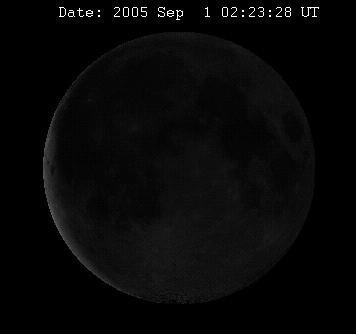
Abb.: Mondphasen (in Indien in Sechzehntel geteilt)
[Bildquelle: Tomruen / Wikipedia. -- Public domain]

Abb.: पौर्णमासी / पौर्णिमा, Udaipur -
उदयपुर, Rajasthan
[Bildquelle:
Fabian Heusser. --
http://www.flickr.com/photos/w3p706/1555479998/. -- Zugriff am 2010-08-19.
-- Creative
Commons Lizenz (Namensnennung, keine kommerzielle Nutzung, share alike)]
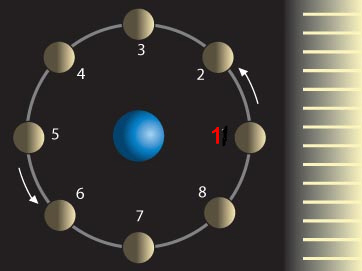
Abb.: सूर्येन्दु-संगमः (1: Neumond)
[Bildquelle: Horst Frank / Wikipedia. -- GNU FDLicense]
9. c./d.
uparāgo graho rāhugraste tv indau ca pūṣṇi ca
10. a./b. sopaplavoparaktau dvāv agnyutpāta upāhitaḥ
उपरागो ग्रहो राहुग्रस्ते त्व् इन्दौ च पूष्णि च ॥९ ख॥
सोपप्लवोपरक्तौ द्वाव् अग्न्युत्पात उपाहितः ।१० क।
Wenn Mond bzw. Sonne von Rāhu1 gefressen wurden, dann heißt das
Der verfinsterte Mond bzw. die verfinsterte Sonne heißen
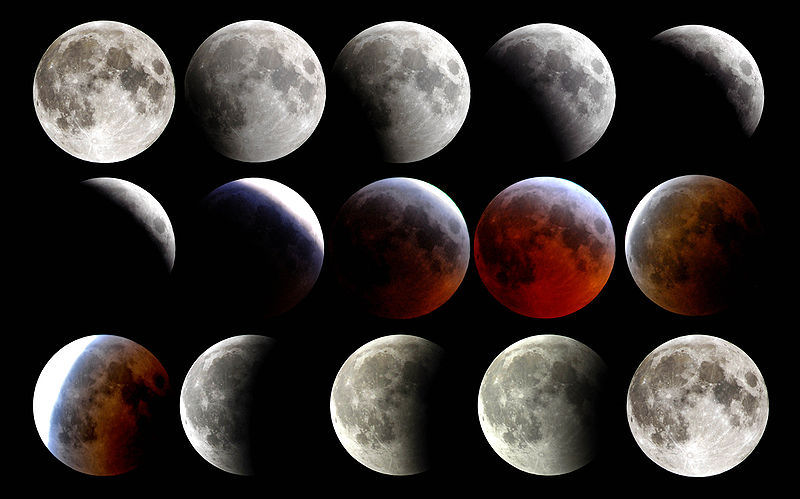
Abb.: Totale Mondfinsternis
[Bildquelle: U. S. Navy. --
http://www.navy.mil/view_single.asp?id=43731. -- Public domain]

Abb.: Totale Sonnenfinsternis, Varanasi, 2009-07-29
[Bildquelle: Manoj.dayyala / Wikipedia. -- GNU FDLicense]
Erläuterungen:
1 Rāhu: lauert am aufsteigenden Drachenpunkt (Mondknoten)
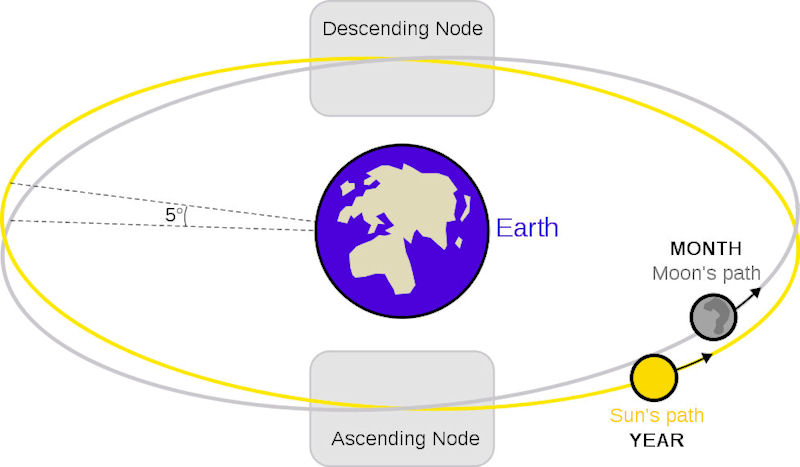
Abb.: Lage von Rāhu und Ketu an den Drachenpunkten (Mondknoten)
[Bildquelle: SuperManu / Wikimedia commons. -- Public domain.]
Siehe:
Payer, Alois <1944 - >: Dharmashastra : Einführung und Überblick. -- 10. Sakramente und Übergangsriten (samskara). -- Anhang C: Rahu und Ketu, die unsichtbaren Wandelsterne . -- URL: http://www.payer.de/dharmashastra/dharmash10c.htm
"Die Mondknoten oder Drachenpunkte sind die Schnittpunkte der Mondbahn mit der Ekliptikebene. Der aufsteigende Mondknoten (übliches Symbol: ☊) ist derjenige, bei dem der Mond von der südlichen auf die nördliche Seite der Ekliptik wechselt. Im absteigenden Mondknoten (☋) wechselt der Mond auf die Südseite der Ekliptik. Die Verbindung der beiden Knoten heißt Knotenlinie.
Knotenpunkte und FinsternisseNur in der Nähe eines Durchgangs des Mondes durch einen der Knoten – bei gleichzeitigem Voll- oder Neumond – ist eine Mond- bzw. Sonnenfinsternis möglich. Das Zeitintervall zwischen zwei Durchgängen der Sonne durch denselben Mondknoten bezeichnet man als Finsternisjahr.
Von dem Bild des Drachens, der die Sonne bzw. den Mond verschluckt, leitet sich der alte Ausdruck Drachenpunkt (lateinisch draco „Drache“) ab: Die Mondknoten waren auch als Drachenkopf (Caput draconis, aufsteigender Mondknoten) bzw. Drachenschwanz (Cauda draconis, absteigender Mondknoten) bekannt und besaßen eine besondere Bedeutung. Dieselbe etymologische Bedeutung steckt in der „Ekliptik“ (griechisch éκlιpsi – wörtlich „Verdeckung, Auslöschung“)."
[Quelle: http://de.wikipedia.org/wiki/Mondknoten. -- Zugriff am 2010-07-13]
"RĀHU. Rāhu and Ketu are in astronomy the ascending and descending nodes. Rāhu is the cause of eclipses, and the term is used to designate the eclipse itself. He is also considered as one of the planets, as king of meteors, and as guardian of the south-west quarter. Mythologically Rāhu is a Daitya who is supposed to seize the sun and moon and swallow them, thus obscuring their rays and causing eclipses. He was son of Vipracitti and Sinhikā, and is called by his metronymic Sainhikeya. He had four arms, and his lower part ended in a tail. He was a great mischief-maker, and when the gods had produced the Amṛta by churning the ocean, he assumed a disguise, and insinuating himself amongst them, drank some of it. The sun and moon detected him and informed Viṣṇu, who cut off his head and two of his arms, but, as he had secured immortality, his body was placed in the stellar sphere, the upper parts, represented by a dragon s head, the ascending node, and the lower parts, represented by a dragon s tail, being Ketu the descending node. Rāhu wreaks his vengeance on the sun and moon by occasionally swallowing them. The Viṣṇu Purāṇa says, "Eight black horses draw the dusky chariot of Rāhu, and once harnessed are attached to it for ever. On the Parvans (nodes, or lunar and solar eclipses) Rāhu directs his course from the sun to the moon, and back again from the moon to the sun. The eight horses of the chariot of Ketu, swift as the wind, are of the dusky red colour of lac, or of the smoke of burning straw." Rāhu is called Abhra-piśāca, 'the demon of the sky' ; Bharaṇī-bhū, 'born from the asterism Bharaṇī'; Graha, 'the seizer' ; Kabandha, 'the headless'."
[Quelle: Dowson, John <1820-1881>: A classical dictionary of Hindu mythology and religion, geography, history, and literature. -- London, Trübner, 1879. -- s.v. ]
10. a./b. sopaplavoparaktau dvāv agnyutpāta upāhitaḥ
सोपप्लवोपरक्तौ द्वाव्
अग्न्युत्पात उपाहितः ।१० क।
[Bezeichnungen für fallende Himmelskörper (Sternschnuppe / Meteor / Komet) sind:]

Abb.: अग्न्युत्पातः / उपाहितः : Leoniden-Meteor
[Bildquelle: Navicore / Wikipedia. --
Creative Commons
Lizenz (Namensnennung)]
10. c./d. ekayoktyā puṣpavantau divākara-niśākarau
एकयोक्त्या पुष्पवन्तौ दिवाकर-निशाकरौ ॥१० ख॥
Mit einem einzigen Wort bezeichnet man Sonne und Mond zusammen als पुष्पवन्तौ m.
(Dual): "die Blumigen", Sonne und Mond zusammen.
11. aṣṭādaśa nimeṣās tu kāṣṭā triṃśat tu tāḥ kalā
tās tu triṃśat kṣaṇas te tu muhūrto dvādaśāstriyām
12. te tu triṃśad ahorātraḥ pakṣas te daśapañca ca
pakṣau pūrvāparau śukla-kṛṣṇau māsas tu tāv ubhau
13. dvau dvau māghādi-māsaua syād ṛtus tair ayanaṃ tribhiḥ
ayane dve gatir udag-dakṣiṇārkasya vatsara
अष्टदश निमेशास् तु काष्टा त्रिंशत् तु ताः कला ।
तास् तु त्रिंशत् क्षणस् ते तु मुहूर्तो द्वादशास्त्रियाम् ॥११॥
ते तु त्रिंशद् अहोरात्रः पक्षस् ते दशपञ्च च ।
पक्षौ पूर्वापरौ शुक्ल-कृष्णौ मासस् तु ताव् उभौ ॥१२॥
द्वौ द्वौ माघादि-मासौa स्याद् ऋतुस् तैर् अयनं त्रिभिः ।
अयने द्वे गतिर् उदग्-दक्षिणार्कस्य वत्सरः ॥१३॥
a var. lect mārgādi-māsau - मार्गादि-मासौ
Erläuterungen:
1 Achtung! Die genannten Umrechnungen in unsere Zeitrechnung gelten nur
für den Amarakośa. In anderen Werken gibt es andere Gleichsetzungen der
verschiedenen Zeiteinheiten. Es ist klar, dass es regional, lokal, berufsmäßig
und historisch sehr unterschiedliche Systeme gab.
2 पक्ष m.: halber Mondzyklus (Halbmonat)
"The lunar fortnight. The lunar month is divided into two fortnights (paksha), called bright and dark, or, in Indian terms, śukla or śuddka, śudi, sudi, and kṛishṇa or bahula, badi, vadi: the bright fortnight, śukla-paksha, is the period of the waxing moon, ending at the full-moon; the dark fortnight, kṛishṇa-paksha, is the period of the waning moon, ending at the newmoon. In the amānta or śuklādi month, the brighl fortnight precedes the dark; in the pūrṇimānta or kṛishṇādi month, the dark fortnight comes first; and the result is that, whereas, for instance, the bright fortnight of Chaitra is the same period of lime ihroughout India, the preceding dark fortnight is known in Northern India as the dark fortnight of Chaitra, but in Southern India as the dark fortnight of Phālguna. This, however, does not affect the period covered by the lunar year; the Chairādi and Kārttikādi years begin everywhere with the bright fortnight of Chaitra and Kārttika respectively; simply, by the amānta system the dark fortnights of Chaitra and Kārttika are the second fortnights, and by the pūrṇimānta system they are the last fortnights, of the years. Like the month, the fortnight begins for religious purposes with its first lunar day, and for civil purposes with its first civil day."
[Quelle: Fleet, J. F. (John Faithful) <1847-1917>: Hindu Chronology. -- In: Encyclopaedia Britannica. -- 11. ed. -- Vol 13. -- 1910. -- S. 491 - 501.]
3 मास m.: "Monat"
"The solar months. The solar year is divided into twelve months, in accordance with the successive saṃkrānis or entrances of the sun into the (sidereal) signs of the zodiac, which, as with us, are twelve in The solar number. The names of the signs in Sanskrit are as follows:
Mesha, the ram (Aries);
Vṛishabha, the bull (Taurus);
Mithuna, the pair, the twins (Gemini);
Karka, Karkaṭa, Karkaṭaka, the crab (Cancer) ;
Siṃha, the lion (Leo) ;
Kanyā, the maiden (Virgo) ;
Tulā, the scales (Libra) ;
Vṛiśchika, the scorpion (Scorpio) ;
Dhanus, the bow (Sagittarius) ;
Makara, the seamonster (Capricornus) ;
Kumbha, the water-pot (Aquarius) ; and
Mīna, the fishes (Pisces).
The solar months are known in some parts by the names of the signs or by corrupted forms of them; and these are the best names for them for general use, because they lead to no confusion. But they have elsewhere another set of names, preserving the connexion of them with the lunar months: the Sanskrit forms of these names are
Chaitra,
Vaiśākha,
Jyaishṭha,
Āshāḍha,
Śrāvaṇa,
Bhādrapada,
Āśvina or Āśvayuja,
Kārttika,
Mārgaśira or Mārgaśīrsha (also known as Agrahāyaṇa),
Pausha,
Māgha, and
Phālguna:
in some localities these names are used in corrupted forms, and in others vernacular names are substituted for some of them ; and, while in some parts the name Chaitra is attached to the month Mesha, in other parts it is attached to the month Mīna, and so on throughout the series in each case. The astronomical solar month runs from the moment of one saṃkrānti of the sun to the moment of the next saṃkrānti; and, as the signs of the Hindu zodiac are all of equal length, 30 degrees, as with us, while the speed of the sun (the motion of the earth in its orbit round the sun) varies according to the time of the year, the length of the month is variable: the shortest month is Dhanus; the longest is Mithuna. The civil solar month begins with its first civil day, which is determined, in different localities, in the same manner with the first civil day of the Meshdi year, as indicated above. The civil month is of variable length; partly for that reason, partly because of the variation in the length of the astronomical month. No exact equivalents of the civil months, therefore, can be stated; but, speaking approximately, we may say that, while the month Mesha now begins on or closely about 12th April, the beginning of a subsequent month may come as late as the 16th day of the English month in which it falls."
[Quelle: Fleet, J. F. (John Faithful) <1847-1917>: Hindu Chronology. -- In: Encyclopaedia Britannica. -- 11. ed. -- Vol 13. -- 1910. -- S. 491 - 501.]
4 ऋतु m.: "Jahreszeit"
Zu den Jahreszeiten folgender Vers:
vasantaś caitravaiśākhau
jyeṣṭhāṣāḍhau ca grīṣmakau |
varṣā śrāvaṇabhādrābhyāṃ
śarad aśvinakārtikau ||
mārgapauṣau ca hemantaḥ
śiśiro māghaphālgunau |
- Frühling (vasanta) ist die Monate Caitra (März/April) und Vaiśākha,
- Jyeṣṭha (Mai/Juni) und Aṣādha sind die beiden Sommermonate (grīṣma),
- Regenzeit (varṣā) ist in den Monaten Śrāvaṇa (Juli/August) und Bhādra,
- Herbst (śarad) ist die Monate Aśvin (September/Oktober) und Kārtika,
- Winter (hemanta) ist die Monate Mārga (November/Dezember) und Pauṣa
- Kühle Jahreszeit (śiśira) ist die Monate Māgha (Januar Februar) und Phalguna
Gorakṣasamhitā, zitiert in Apte, Dict. s.v. ṛtu
"The seasons. The solar year is also divided into six seasons, the Sanskrit names of which are
Vasanta, spring;
Grīshma, the hot weather;
Varshā, the rainy season ;
Śarad, autumn ;
Hemanta, the cold weather; and
Śiśira, the dewy season.
Vasanta begins at the Mīna-saṃkrānti ; the other seasons begin at each successive second saṃkrānti from that. Originally, this scheme was laid out with reference to the true course of the sun, and the startingpoint of it was the real winter solstice, with Śiśira, as the first season, beginning then: now, owing partly to the disregard of precession, partly to our introduction of New Style, each season comes about three weeks too late; Vasanta begins on or about 12th March, instead of 19th or 20th February, and so on with the rest.
It may be added that in early times the year was also divided into three or four, and even into five or seven, seasons; and there appears to have been also a practice of reckoning the seasons according to the lunar months, which, however, would only give a very varying arrangement, in addition to neglecting the point that the seasons are naturally determined by the course of the sun, not of the moon. But there is now recognized only the division into six seasons, determined as stated above."
[Quelle: Fleet, J. F. (John Faithful) <1847-1917>: Hindu Chronology. -- In: Encyclopaedia Britannica. -- 11. ed. -- Vol 13. -- 1910. -- S. 491 - 501.]
5 अयन n.: "Halbjahr"
"The solstitial divisions of the year. The solar year is also divided into two parts called
Uttarāyaṇa,the period during which the sun is moving to the north, and
Dakshiṇāyana, the period during which it is moving to the south.
The Uttarāyaṇa begins at the nominal winter solstice, as marked by the Makara-saṃkrānti ; and the day on which this solstice occurs, usually 12th January at present, is still a special occasion of festivity and rejoicing; the Dakshiṇāyana begins at the nominal summer solstice, as marked by the Karka-saṃkrānti.
It may be added here that, while the Hindus disregard precession in the actual computation of their years and the regulation of their calendar, they pay attention to it in certain other respects, and notably as regards the solstices: the precessional solstices are looked upon as auspicious occasions, as well as the non-precessional solstices, and are customarily shown in the almanacs; and some of the almanacs show also the other precessional saṃkrāntis of the sun."
[Quelle: Fleet, J. F. (John Faithful) <1847-1917>: Hindu Chronology. -- In: Encyclopaedia Britannica. -- 11. ed. -- Vol 13. -- 1910. -- S. 491 - 501.]
14. a./b. sama-rātri-dive kāle viṣuvad viṣuvaṃ ca tat
सम-रात्रि-दिवे काले विषुवद् विषुवं च तत् ।१४ क।
Der Zeitpunkt, an dem Tag und Nacht gleich lang sind, heißt
Erläuterungen
1 विषुवद् n.: Tag- und Nachtgleiche, Äquinoktium
Der Himmelsäquator (englisch celestial equator) ist um ~23.5° zur Ebene der Ekliptik geneigt. Die Schnittpunkte sind die Äquinoktien.
[Bildquelle: NASA / Wikipedia. -- Public domain]"Tagundnachtgleiche
Die Tagundnachtgleichen markieren den Beginn des astronomischen Frühlings bzw. des astronomischen Herbstes. Die Sonne steht dann auf dem Himmelsäquator, also auch senkrecht über dem Erdäquator.
- Zwischen 19. und 21. März läuft die Sonne durch den Frühlingspunkt und überschreitet auf ihrer scheinbaren jährlichen Bahn am Himmel (Ekliptik) den Himmelsäquator von Süden nach Norden. Danach befindet sie sich auf der nördlichen Himmelshälfte, das heißt die Nordhalbkugel der Erde ist der Sonne zugewandt.
- Am 22. oder 23. September läuft die Sonne durch den Herbstpunkt und überschreitet den Himmelsäquator von Norden nach Süden. Danach befindet sie sich auf der südlichen Himmelshälfte, das heißt die Südhalbkugel der Erde ist der Sonne zugewandt.
Auf der Nordhalbkugel beginnt mit der März-Tagundnachtgleiche der Frühling und mit der September-Tagundnachtgleiche der Herbst. Auf der Südhalbkugel beginnt mit der März-Tagundnachtgleiche der Herbst und mit der September-Tagundnachtgleiche der Frühling.
Zu den Tagundnachtgleichen sind überall auf der Erde Tag und Nacht (ungefähr, siehe unten) gleich lang, weil jeweils die Hälfte der täglichen Sonnenbahn (dem Tagbogen) oberhalb bzw. unterhalb des Horizonts liegt. Überall auf der Erde geht die Sonne an diesem Tag fast genau im Osten auf und im Westen unter.
Zwischen den Äquinoktien liegen die Sonnenwenden, also die Zeitpunkte, in denen die Sonne ihren größten Abstand vom Himmelsäquator erreicht und senkrecht über den Wendekreisen der Erde steht. Äquinoktien und Sonnenwenden stellen den Beginn der jeweiligen astronomischen Jahreszeiten dar.
Definitionsgemäß geht die Sonne bereits dann auf, wenn ihr oberer Rand die Horizontlinie überschreitet (siehe Aufgang (Astronomie)), also eine kurze Zeitspanne bevor ihr Mittelpunkt über den Horizont tritt. Abends ereignet sich der Sonnenuntergang eine kurze Zeitspanne nachdem der Sonnenmittelpunkt unter den Horizont gesunken ist, nämlich dann, wenn der letzte Sonnenstrahl des oberen Sonnenrandes erlischt (insgesamt etwa 0,5°). Aber auch die Lichtbrechung, die eine scheinbare Anhebung der Sonnenscheibe um etwa 0,6° am Horizont bewirkt, verursacht eine Verlängerung des lichten Tages gegenüber der Nacht. Tag und Nacht sind daher zum Zeitpunkt der Tagundnachtgleichen nicht wirklich gleich lang, sondern die Nacht um knapp 7 Minuten zugunsten des Tages verkürzt (0,5° plus 1,2°; 1° entspricht 24*60/360 = 4 Minuten). Der Begriff „Tagundnachtgleiche“ hat sich dennoch eingebürgert; er stammt aus der sphärischen Astronomie, in der atmosphärische Einflüsse und die Ausdehnung der Sonnenscheibe ignoriert werden und beschreibt den Umstand, dass Tagbogen und Nachtbogen eines auf dem Himmelsäquator stehenden Punktes (wie zum Beispiel des Sonnenmittelpunktes zur Tagundnachtgleiche) gleich lang sind.
DatumWeil die durchschnittliche Dauer eines Umlaufs der Erde um die Sonne (Sonnenjahr) mit 365,24219879 Tagen knapp sechs Stunden länger ist als die Länge eines kalendarischen Gemeinjahres mit genau 365 Tagen, verschiebt sich der Eintritts-Zeitpunkt der Äquinoktien jedes Jahr um etwa sechs Stunden zu späteren Uhrzeiten. In Schaltjahren (zum Beispiel 2004, 2008; siehe Tabelle) erfolgt der Eintritts-Zeitpunkt der Äquinoktien jedoch auf Grund der Einfügung des 29. Februar einen ganzen Tag früher. Dadurch ergibt sich im Vergleich zum Vorjahr eine um etwa 18 Stunden frühere Uhrzeit des Äquinoktial-Zeitpunktes."
[Quelle: http://de.wikipedia.org/wiki/Äquinoktium. -- Zugriff am 2010-08-19]
14. c./d.
mārgaśīrṣe sahā mārga āgrahāyaṇikaś ca saḥ
15. pauṣe taiṣa-sahasyau dvau tapā māghe 'tha phālgune
syāt tapasyaḥ phālgunikaḥ syāc caitre caitriko madhuḥ
16. vaiśākhe mādhavo rādho jyaiṣṭhe śukraḥ śucis tv ayam
āṣāḍhe śrāvaṇe tu syān nabhāḥ śrāvaṇikaś ca saḥ
17. syur nabhasya prauṣṭhapada-bhādra-bhādrapadāḥ samāḥ
syād āśvina iṣo 'py āśvayujo 'pi syāt tu kārtike
18. a./b. bāhulorjau kārtikiko hemantaḥ śiśiro 'striyām
मार्गशीर्षे सहा मार्ग आग्रहायणिकश् च सः ॥१४ ख॥
पौषे तैष-सहस्यौ द्वौ तपा माघे
ऽथ
फाल्गुने ।
स्यात् तपस्यः फाल्गुनिकः स्याच् चैत्रे चैत्रिको मधुः ॥१५॥
वैशाखे माधवो राधो
ज्यैष्ठे शुक्रः शुचिस् त्व् अयम् ।
आषाढे श्रावणे तु स्यान् नभाः श्रावणिकश् च सः ॥१६॥
स्युर् नभस्य प्रौष्ठपद-भाद्र-भाद्रपदाः समाः ।
स्याद् आश्विन इषो
ऽपि
आश्वयुजो
ऽपि स्यात् तु कार्तिके ॥१७॥
बाहुलोर्जौ कार्तिकिको हेमन्तः शिशिरो ऽस्त्रियाम् ।१८
क।
Für den Monat मार्गशीर्ष m.1 sagt man auch:
Für den Monat पौष m.2 sagt man auch:
Für den Monat माघ m.3 sagt man auch तपस् m.: Tapas
Für den Monat फाल्गुन m.4 sagt man auch
Für den Monat चैत्र m.5 sagt man auch
Für den Monat वैशाख m.6 sagt man auch
Für den Monat ज्यैष्ठ m.7 sagt man auch शुक्र m.: Heller, Śukra.
Für den Monat आषाढ m.8 sagt man auch शुचि m.: Leuchtender, Śuci.
Für den Monat श्रावण m.9 sagt man auch
Folgende Monatsnamen sind gleichbedeutend
Für den Monat आश्विन m.11 sagt man auch
Für den Monat कार्तिक m.12 sagt man auch:
Erläuterungen:
Monat Synonyme
Dauer nach neuem indischen nationalen Kalender Nakṣatra des Vollmonds मार्गशीर्ष m. - Mārgaśīrṣa सहस् m. - Sahas
मार्ग m. - Mārga
आग्रहायणिक m. - Āgrahāyaṇika22. November bis 21. Dezember Mṛgaśiras / Mṛgaśīrṣā = λ, φ Orionis पौष m. - Pauṣa तैष m.: Taiṣa
सहस्य m.: Sahasya22. Dezember bis 20. Januar Puṣya = γ, δ and θ Cancri माघ m. - Māgha तपस् m.: Tapas 21. Januar bis 19. Februar Maghā = Regulus = α Leonis फाल्गुन m. - Phālguna तपस्य m.: Tapasya
फाल्गुनिक m.: Phālgunika20. Februar bis 21. März
(in Schaltjahren: 20. März)Phalguni = δ and θ Leonis bzw. = Denebola = β Leonis चैत्र m. - Caitra चैत्रिक m.: Caitrika
मधु m.: Madhu22./21. März bis 20. April Spica = α Virginis वैशाख m. - Vaiśākha माधव m.: Mādhava
राध m.: Rādha21. April bis 21. Mai Viśākhā = α, β, γ and ι Librae ज्यैष्ठ m. - Jyaiṣṭha शुक्र m.: Śukra 22. Mai bis 21. Juni Jyeṣṭhā = α, σ, and τ Scorpionis आषाढ m. - Āṣāḍha शुचि m.: Śuci 22. Juni bis 22. Juli Aṣādhā = δ and ε Sagittarii bzw. = ζ and σ Sagittarii श्रावण m. - Śrāvaṇa नभस् m.: Nabhas
श्रावणिक m.: Śrāvaṇika23. Juli bis zum 22. August Śravaṇa = α, β and γ Aquilae भाद्रपद m. - Bhādrapada भाद्र m.: Bhādra
प्रौष्ठपद m.: Prauṣṭhapada
नभस्य m.: Nabhasya23. August bis 22. September Bhadrapadā = α and β Pegasi bzw. = γ Pegasi und α Andromedae आश्विन m. - Āśvina इष m.: Iṣa
आश्वयुज m.: Āśvayuja23. September bis 22. Oktober Aśvinī = β and γ Arietis कार्तिक m. - Kārtika बाहुल m.: Bāhula
ऊर्ज m.: Ūrja
कार्तिकिक m.: Kārtikika23. Oktober bis 21. November Kṛttikā = Pleiaden (Siebengestirn)
1 मार्गशीर्ष m. - Mārgaśīrṣa
Nach dem neuen indischen nationalen Kalender dauert मार्गशीर्ष (Mārgaśīrṣa) vom 22. November bis zum 21. Dezember.
मार्गशीर्ष (Mārgaśīrṣa) ist benannt nach dem Nakṣatra Mṛgaśiras / Mṛgaśīrṣā = λ, φ Orionis, in welchem der Vollmond dieses Monats stand.
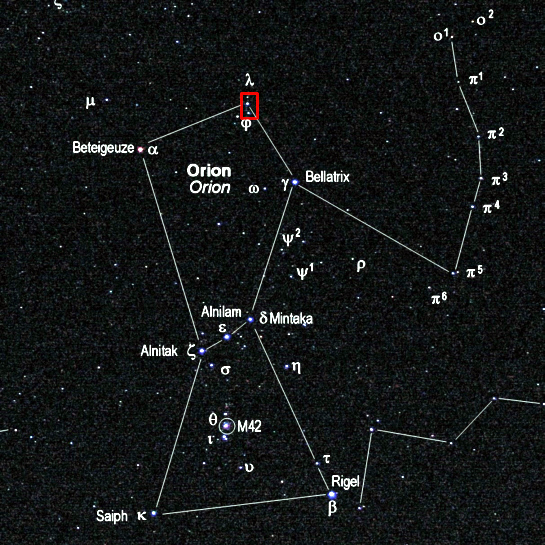
Abb.: Mṛgaśiras / Mṛgaśīrṣā = λ, φ Orionis
[Bildquelle: Stephan Brunker / Wikipedia. -- GNU FDLicense]
2 पौष m. - Pauṣa
Nach dem neuen indischen nationalen Kalender dauert पौष (Pauṣa) vom 22. Dezember bis zum 20. Januar.
Benannt nach dem Nakṣatra Puṣya = γ, δ and θ Cancri, in welchem der Vollmond dieses Monats stand.
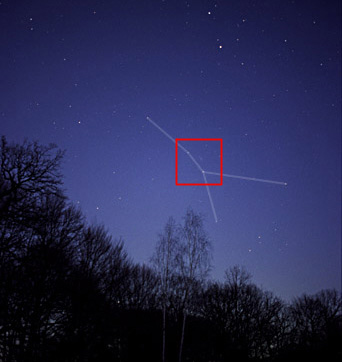
Abb.: Puṣya = γ, δ and θ
Cancri
[Bildquelle: Till Credner / Bedwyr / Wikipedia. -- GNU FDLicense]
3 माघ m. - Māgha
Nach dem neuen indischen nationalen Kalender dauert माघ (Māgha) vom 21. Januar bis zum 19. Februar
Benannt nach dem Nakṣatra Maghā = Regulus = α Leonis, in welchem der Vollmond dieses Monats stand.
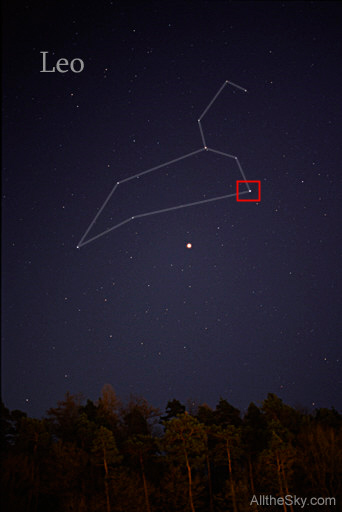
Abb.: Maghā = Regulus = α
Leonis
[Bildquelle: Till Credner / Wikipedia. -- GNU FDLicense]
4 फाल्गुन m. - Phālguna
Nach dem neuen indischen nationalen Kalender dauert फाल्गुन (Phālguna) vom 20. Februar bis zum 21. März (in Schaltjahren: 20. März)
Benannt nach dem Nakṣatra Phalguni = δ and θ Leonis bzw. = Denebola = β Leonis, in welchem der Vollmond dieses Monats stand.
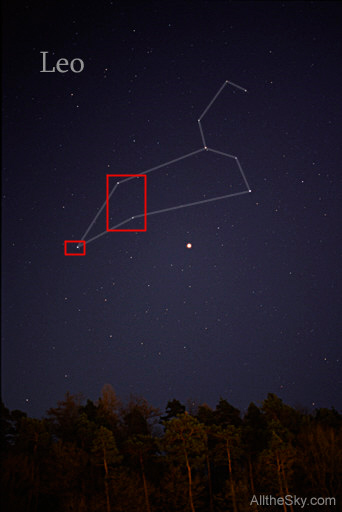
Abb.: Phalguni = δ and θ
Leonis bzw. = Denebola
= β Leonis
[Bildquelle: Till Credner / Wikipedia. -- GNU FDLicense]
5 चैत्र m. - Caitra
Nach dem neuen indischen nationalen Kalender dauert चैत्र (Caitra) vom 22./21. März bis zum 20. April.
Benannt nach dem Nakṣatra Citrā = Spica = α Virginis, in welchem der Vollmond dieses Monats stand.
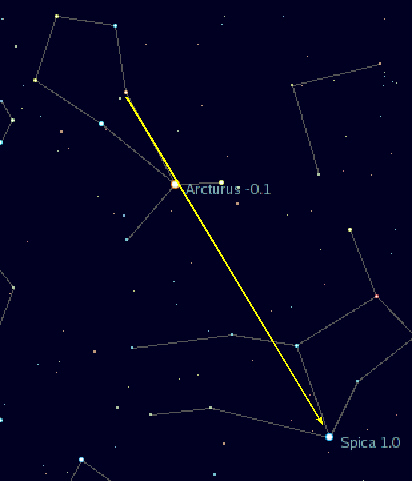
Abb.: Citrā = Spica = α Virginis
[Bildquelle: Jomegat / Wikipedia. -- GNU FDLicense]
6 वैशाख m. - Vaiśākha
Nach dem neuen indischen nationalen Kalender dauert वैशाख (Vaiśākha) vom 21. April bis zum 20. Mai.
Benannt nach dem Nakṣatra Viśākhā = α, β, γ and ι Librae, in welchem der Vollmond dieses Monats stand.
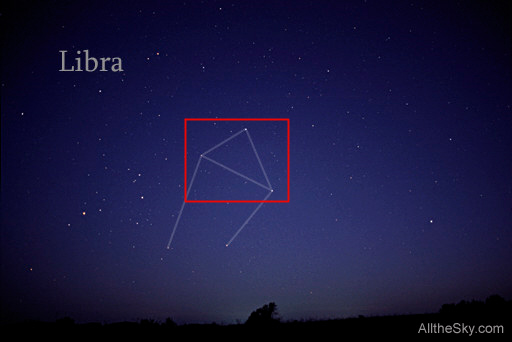
Abb.: Viśākhā = α, β, γ
and ι Librae
[Bildquelle: Till Credner / Wikipedia. -- GNU FDLicense]
7 ज्यैष्ठ m.: Jyaiṣṭha
Nach dem neuen indischen nationalen Kalender dauert ज्यैष्ठ (Jyaiṣṭha) vom 21. Mai bis zum 22. Juni.
Benannt nach dem Nakṣatra Jyeṣṭhā = α, σ, and τ Scorpionis, in welchem der Vollmond dieses Monats stand.
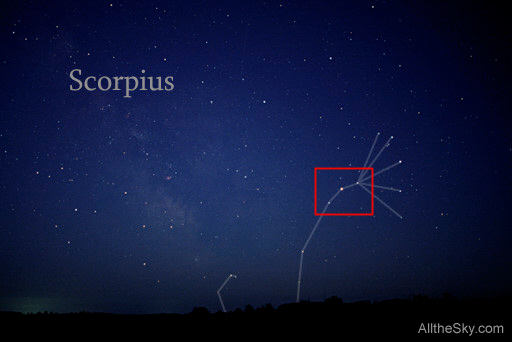
Abb.: Jyeṣṭhā = α, σ, and τ Scorpionis
[Bildquelle: Till Credner / Wikipedia. -- GNU FDLicense]
8 आषाढ m. - Āṣāḍha
Nach dem neuen indischen nationalen Kalender dauert आषाढ (Āṣāḍha) vom 22. Juni bis zum 22 Juli.
Benannt nach dem Nakṣatra Aṣādhā = δ and ε Sagittarii bzw. = ζ and σ Sagittarii, in welchem der Vollmond dieses Monats stand.
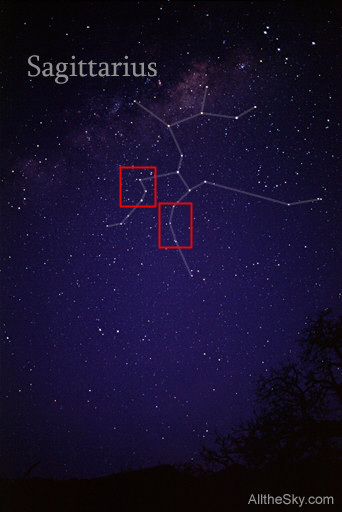
Abb.: Aṣādhā = δ and ε
Sagittarii bzw. = ζ and σ Sagittarii
[Bildquelle: Till Credner / Wikipedia. -- GNU FDLicense]
9 श्रावण m. - Śrāvaṇa
Nach dem neuen indischen nationalen Kalender dauert श्रावण (Śrāvaṇa) vom 23. Juli bis zum 22. August.
Benannt nach dem Nakṣatra Śravaṇa = α, β and γ Aquilae, in welchem der Vollmond dieses Monats stand.
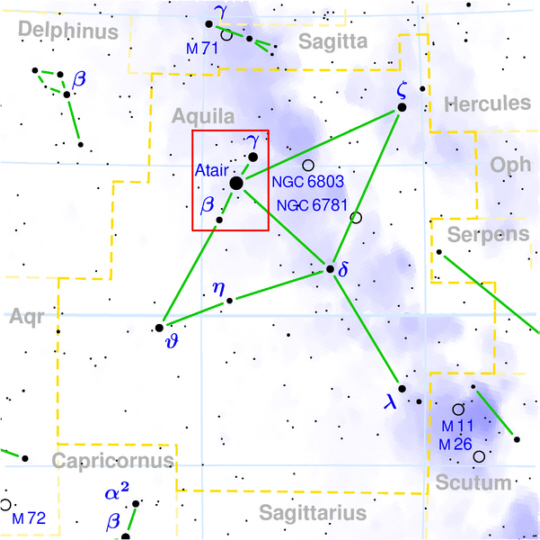
Abb.: Śravaṇa = α, β and γ
Aquilae
[Bildquelle: Torsten Bronger / Wikipedia. -- GNU FDLicense]
10 भाद्रपद m.: Bhādrapada
Nach dem neuen indischen nationalen Kalender dauert भाद्रपद (Bhādrapada) vom 23. August bis zum 22. September.
Benannt nach dem Nakṣatra Bhadrapadā = α and β Pegasi bzw. = γ Pegasi und α Andromedae, in welchem der Vollmond dieses Monats stand.
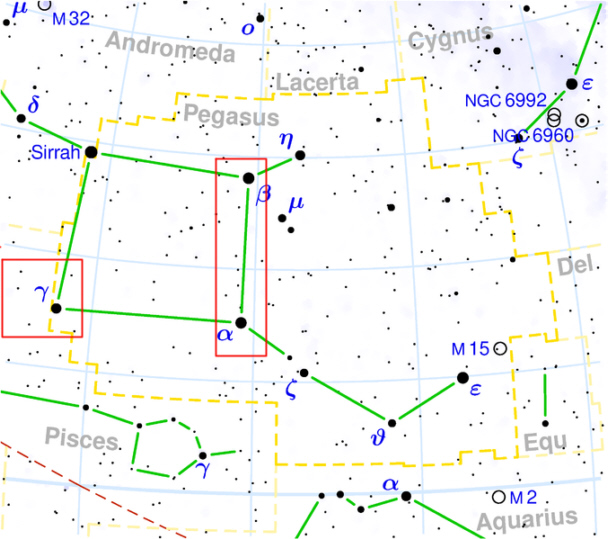
Abb.: Bhadrapadā = α and β
Pegasi bzw. = γ Pegasi und α Andromedae
[Bildquelle: Torsten Bronger / Wikipedia. -- GNU FDLicense]
11 आश्विन m. - Āśvina
Nach dem neuen indischen nationalen Kalender dauert आश्विन (Āśvina) vom 23. September bis zum 22. Oktober.
Benannt nach dem Nakṣatra Aśvinī = β and γ Arietis, in welchem der Vollmond dieses Monats stand.
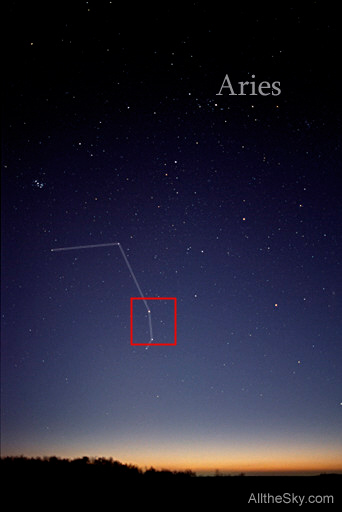
Abb.: Aśvinī = β and γ
Arietis
[Bildquelle: Till Credner / Wikipedia. -- GNU FDLicense]
12 कार्तिक m. - Kārtika
Nach dem neuen indischen nationalen Kalender dauert कार्तिक (Kārtika) vom 23. Oktober bis zum 21. November.
Benannt nach dem Nakṣatra Kṛttikā = Pleiaden (Siebengestirn), in welchem der Vollmond dieses Monats stand.
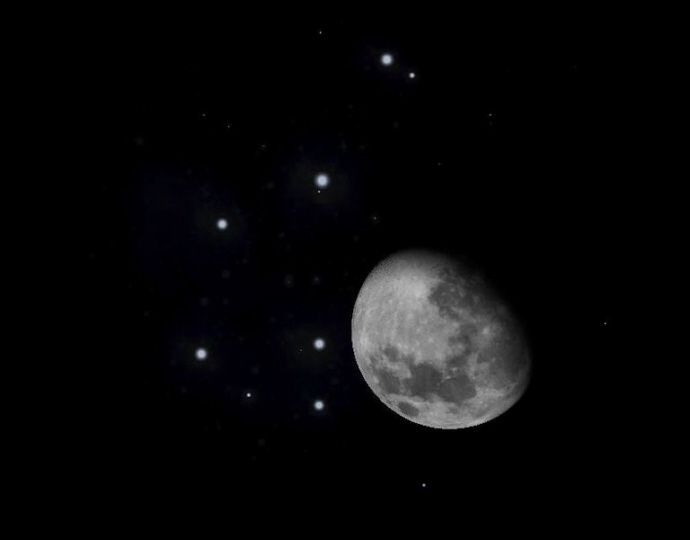
Abb.: Der Mond in Kṛttikā
= Pleiaden (Siebengestirn)
[Bildquelle: Vortix / Wikipedia. -- Public domain]
18. bāhulorjau kārtikiko hemantaḥ śiśiro 'striyām
vasante puṣpasamayaḥ surabhir grīṣma ūṣmakaḥ
19. nidāgha uṣṇopagama uṣṇa ūṣmāgamas tapaḥ
striyāṃ prāvṛṭ striyāṃ bhūmni varṣā atha śarat striyām
20. a./b. ṣaḍ amī ṛtavaḥ puṃsi mārgādīnāṃ yugaiḥ kramāt
बाहुलोर्जौ कार्तिकिको हेमन्तः शिशिरो ऽस्त्रियाम् ।
वसन्ते पुष्पसमयः सुरभिर् ग्रीष्म ऊष्मकः ॥१८॥
निदाघ उष्णोपगम उष्ण ऊष्मागमस् तपः ।
स्त्रियां प्रावृट् स्त्रियां भूम्नि वर्षा अथ शरत् स्त्रियाम् ॥१९॥
षड् अमी ऋतवः पुंसि मार्गादीनां युगैः
क्रमात् ।२० क।
[Die Jahreszeiten sind:]
Diese sechs sind die ऋतु m. - Jahreszeiten werden der Reihe nach von je zwei Monaten, beginnend mit dem Monat Mārga.1
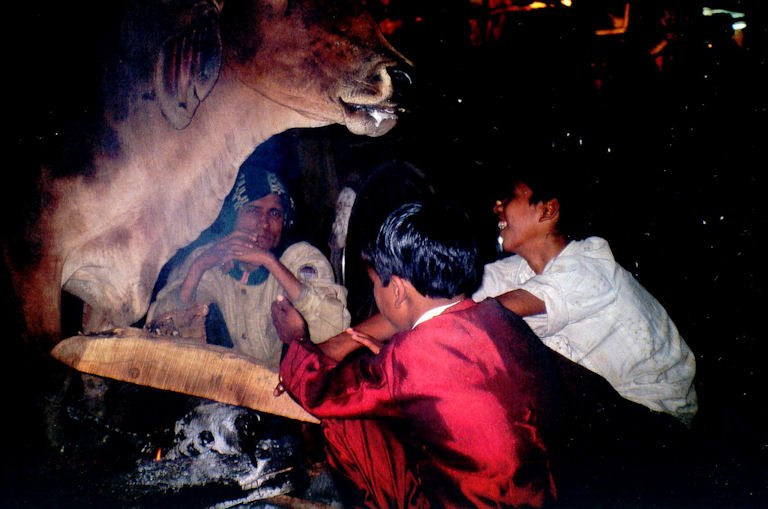
Abb.:
हेमन्तः - "Keeping
warm between a fire and a cow on a cold January evening near Dasasvamedha ghat,
Varanasi India."
[Bildquelle: Ahron de Leeuw. --
http://www.flickr.com/photos/ahron/3401653962/. -- Zugriff am 2010-08-20. --
Creative Commons
Lizenz (Namensnennung)]

Abb.: पुष्पसमयः
- Flammenbaum - Delonix regia
(Bojer ex Hooker) Rafin., New Delhi, 6. Mai 2005
[Bildquelle: Saad Akhtar. --
http://www.flickr.com/photos/17155762@N00/13523666. -- Zugriff am
2010-08-20. --
Creative Commons Lizenz (Namensnennung)]

Abb.:
प्रावृट्,
bei Sodepur -
সোদপুর, West Bengal
[Bildquelle:
dee_gee. --
http://www.flickr.com/photos/dee_gee/214980535/. -- Zugriff am 2010-08-21.
-- Creative
Commons Lizenz (Namensnennung, keine kommerzielle Nutzung, keine
Bearbeitung)]

Abb.:
शरत्
[Bildquelle:
daimalu.
--
http://www.flickr.com/photos/dwimalu/2012833851/#/. -- Zugriff am
2010-08-21. --
Creative Commons Lizenz (Namensnennung)]
Erläuterungen:
1 Jahreszeiten und Monate
Jahreszeit Monat Dauer nach neuem indischen nationalen Kalender हेमन्त m.: Winter मार्गशीर्ष m. - Mārgaśīrṣa 22. November bis 21. Dezember पौष m. - Pauṣa 22. Dezember bis 20. Januar शिशिर m. n.: kühle Jahreszeit, Vorfrühling माघ m. - Māgha 21. Januar bis 19. Februar फाल्गुन m. - Phālguna 20. Februar bis 21. März
(in Schaltjahren: 20. März)वसन्त m.: Frühling चैत्र m. - Caitra 22./21. März bis 20. April वैशाख m. - Vaiśākha 21. April bis 21. Mai ग्रीष्म m.: heiße Jahreszeit, Sommer ज्यैष्ठ m. - Jyaiṣṭha 22. Mai bis 21. Juni आषाढ m. - Āṣāḍha 22. Juni bis 22. Juli प्रावृष् f.: Regenzeit श्रावण m. - Śrāvaṇa 23. Juli bis zum 22. August भाद्रपद m. - Bhādrapada 23. August bis 22. September शरत् f.: Herbst आश्विन m. - Āśvina 23. September bis 22. Oktober कार्तिक m. - Kārtika 23. Oktober bis 21. November
20. c./d. saṃvatsaro vatsaro 'bdo hāyano 'strī śarat samāḥ
संवत्सरो वत्सरो ऽब्दो हायनो ऽस्त्री शरत् समाः ॥२० ख॥
[Bezeichnungen für das irdische Jahr sind:]
21. māsena syād ahorātraḥ paitro varṣeṇa daivataḥ
daive yugasahasre dve brāhmaḥ kalpau tu tau nṛṇām
22. a./b. manvantaraṃ tu divyānāṃ yugānām ekasaptatiḥ
मासेन स्याद् अहोरात्रः पैत्रो वर्षेण दैवतः ।
दैवे युगसहस्रे द्वे ब्राह्मः कल्पौ तु तौ नृणाम् ॥२१॥
मन्वन्तरं तु दिव्यानां युगानाम् एकशप्ततिः ।२२ क।
Erläuterungen:
Die Zeitangaben für Yuga und Manvantara differieren in den verschiedenen Werken beträchtlich.
1 ein Tag und eine Nacht Brahmās dauern je 1000 Götteryugas
"YUGA. An age of the world. Each of these ages is preceded by a period called its Sandhyā or 'twilight', and is followed by another period of equal length called Sandhyāṃsa, 'portion of twilight', each being equal to one-tenth of the Yuga, The Yugas are four in number, and their duration is first computed by years of the gods : -
But a year of the gods is equal to 360 years of men, so
4800 x 360 = 1,728,000 3600 x 360 = 1,296,000 2400 x 360 = 864,000 200 x 360 = 432,000 Total
4,320,000 years, forming the period called a Mahā-yuga or Manvantara.
Two thousand Mahā-yugas or 8,640,000,000 years make a Kalpa or night and a day of Brahma.
This elaborate and practically boundless system of chronology was invented between the age of the Ṛg-veda and that of the Mahā-bhārata. No traces of it are to be found in the hymns of the Ṛg, but it was fully established in the days of the great epic. In this work the four ages are described at length by Hanumat, the learned monkey chief, and from that description the following account has been abridged :
The Kṛta is the age in which righteousness is eternal, when duties did not languish nor people decline. No efforts were made by men, the fruit of the earth was obtained by their mere wish. There was no malice, weeping, pride, or deceit ; no contention, no hatred, cruelty, fear, affliction, jealousy, or envy. The castes alike in their functions fulfilled their duties, were unceasingly devoted to one deity, and used one formula, one rule, and one rite. Though they had separate duties, they had but one Veda and practised one duty.
In the Tretā Yuga sacrifice commenced, righteousness decreased by one-fourth; men adhered to truth, and were devoted to a righteousness dependent on ceremonies. Sacrifices prevailed with holy acts and a variety of rites. Men acted with an object in view, seeking after reward for their rites and their gifts, and were no longer disposed to austerities and to liberality from a simple feeling of duty.
In the Dvāpara Yuga righteousness was diminished by a half. The Veda became fourfold. Some men studied four Vedas, others three, others two, others one, and some none at all. Ceremonies were celebrated in a great variety of ways. From the decline of goodness only few men adhered to truth. When men had fallen away from goodness, many diseases, desires, and calamities, caused by destiny, assailed them, by which they were severely afflicted and driven to practise austerities. Others desiring heavenly bliss offered sacrifices. Thus men declined through unrighteousness.
In the Kali Yuga righteousness remained to the extent of one-fourth only. Practices enjoined by the Vedas, works of righteousness, and rites of sacrifice ceased. Calamities, diseases, fatigue, faults, such as anger, &c., distresses, hunger, and fear prevailed. As the ages revolve righteousness declines, and the people also decline. When they decay their motives grow weak, and the general decline frustrates their aims. - Muir, i.144.
In the Kṛta Yuga the duration of life was four thousand years, in the Tretā three thousand, in the Dvāpara two thousand. In the Kali Yuga there is no fixed measure. Other passages of the Mahārbhārata indicate "that the Kṛta Yuga was regarded as an age in which Brāhmans alone existed, and that Kṣatriyas only began to be born in the Tretā.""
[Quelle: Dowson, John <1820-1881>: A classical dictionary of Hindu mythology and religion, geography, history, and literature. -- London, Trübner, 1879. -- s.v. ]
2 कल्प m. - Kalpa ~ 4.320.000.000 Menschenjahre. Zeit zwischen Entstehung und Vernichtung der Welt, bzw. Vernichtung und Wiederentstehung
"KALPA. A day and night of Brahma, 4,320,000,000 years. See Yuga."
[Quelle: Dowson, John <1820-1881>: A classical dictionary of Hindu mythology and religion, geography, history, and literature. -- London, Trübner, 1879. -- s.v. ]
3 मन्वन्तर n. - Manvantara - Manuperiode
"MANVANTARA (Manu-antara). The life or period of a Manu, 4,320,000 years." [Quelle: Dowson, John <1820-1881>: A classical dictionary of Hindu mythology and religion, geography, history, and literature. -- London, Trübner, 1879. -- s.v. ]
22. c./d. saṃvartaḥ pralayaḥ kalpaḥ kṣayaḥ kalpānta ity api
संवर्तः प्रलयः कल्पः क्षयः कल्पान्त इत्य् अपि ॥२२ ख॥
[Bezeichnungen für den Weltuntergang sind:]
Zu 1.5. Dhīvarga - Abschnitt über den Verstand